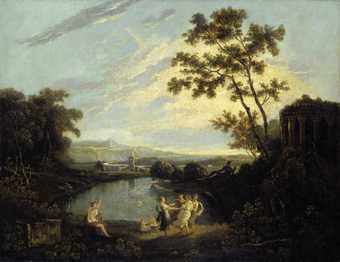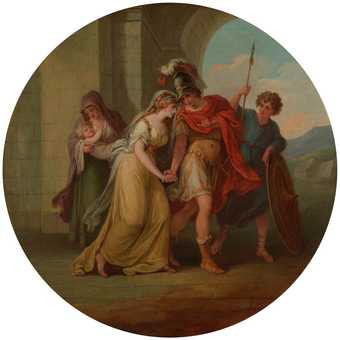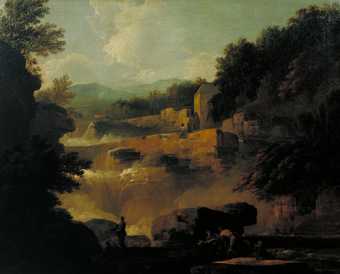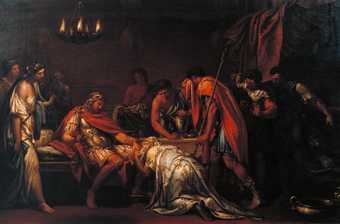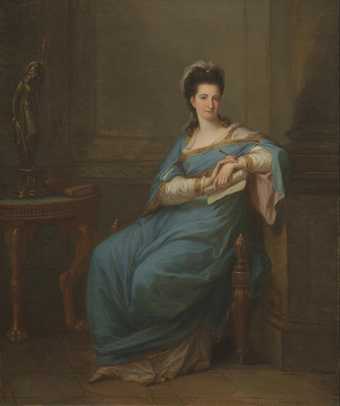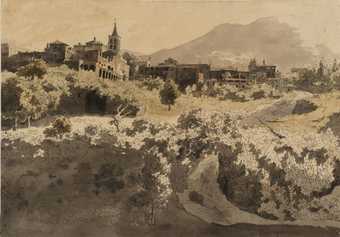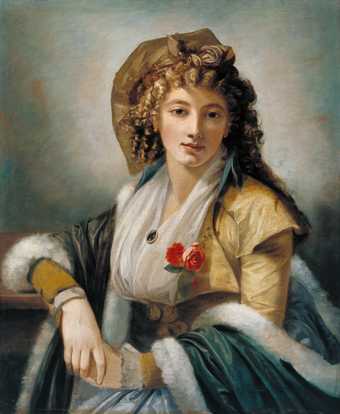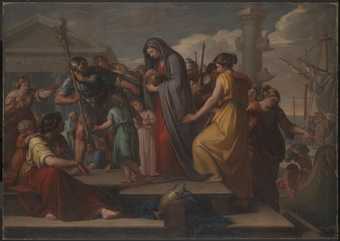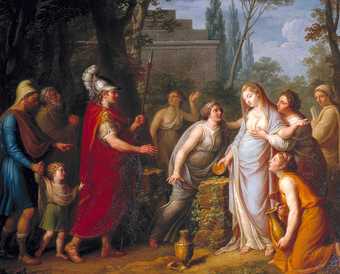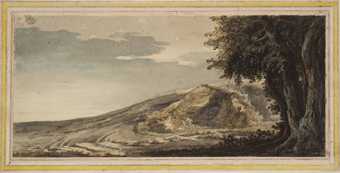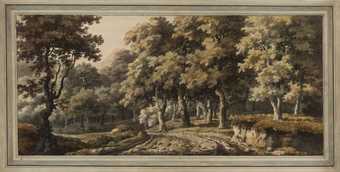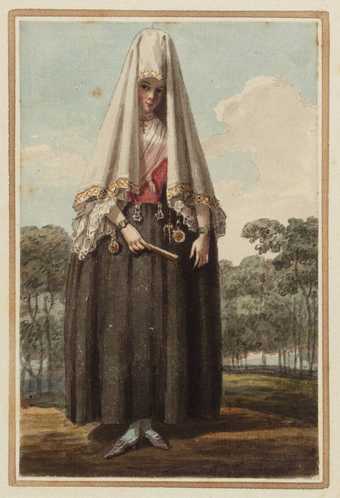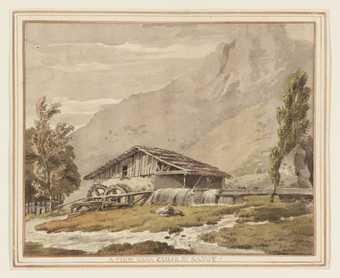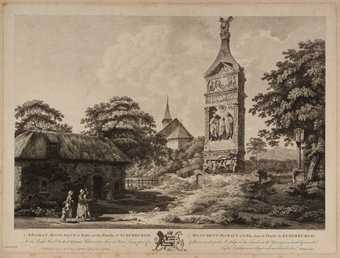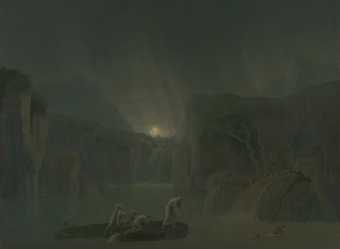
In Tate Britain
- Artist
- Agostino Brunias c.1730–1796
- Medium
- Oil paint on canvas
- Dimensions
- Unconfirmed: 508 × 660 mm
frame: 637 × 788 × 65 mm - Collection
- Tate
- Acquisition
- Purchased with assistance from Tate Patrons and Tate Members 2013
- Reference
- T13869
Summary
This small and vividly coloured oil painting shows a predominantly female group of figures dancing in an open area of bare, sandy ground before two solidly-built two-storey buildings and a hilly, richly vegetated landscape, surmounted on the right by further solid-looking buildings, a thatched hut and a windmill. The setting is intended as the Caribbean, probably St Vincent or Dominica where the Italian-born artist Agostino Brunias was largely based from c.1764 until his death in 1796. Although the early ownership history of this work is not known, Brunias created such idealised views of life in the sugar colonies of the British West Indies to sell to plantation landowners and colonial administrators, although he also published prints in London and Paris which made his images more widely known.
The painting is typical of Brunias’s work, in showing a mixture of men and women from African and mixed African and European descent engaged in leisure-time activities in a public space. The scene therefore includes figures who would have been expected by contemporary viewers to be enslaved (the darker skinned men and women) intermingling with others of higher social status who might be free women of colour (the lighter–skinned women wearing more European-style costumes). The costumes of the figures also combine European and African elements (with turbans and headwraps in combination with corsets and shirts, and all the figures barefoot). Their dance appears to be a street dance on the move, accompanied by a small band moving with tambourines and triangles, perhaps the pre-Lent carnival traditionally known as a Masquerade or Mas’ which is still performed in Dominica.
The purported location of the scene portrayed in the present work can not, however, be confirmed. Brunias often grafted details, figures and even whole groups from one composition to another, even when they purported to represent different communities from separate islands. The present painting bears such a relationship to several extant prints and paintings by Brunias showing both St Vincent and Dominica. As with other images of life in the British West Indies by Brunias the major economic reason for colonisation and the creation of slave plantations in the Caribbean – the production of sugar and coffee – is not made explicitly visible (although the windmill and plantation buildings in the distance register that the land was being worked). Instead, we are treated to a scene of apparently free and independent leisure activity among the Black population. Brunias’s images of Caribbean life have been scrutinised closely as evidence of the complex and distorted European perspective on the slave plantations.
Further reading
Beth Fowkes Tobin, Picturing Imperial Power: Colonial Subjects in Eighteenth-Century British Painting, Durham and London 1999, pp.139–73.
Kay Dian Kriz, Slavery, Sugar, and the Culture of Refinement: Picturing the British West Indies 1700–1840, New Haven and London 2008, pp.37–71.
Mia L. Bagneris, Agostino Brunias: Capturing the Carribean [sic] (c.1770–1800), London 2010.
Martin Myrone
September 2013
Does this text contain inaccurate information or language that you feel we should improve or change? We would like to hear from you.
Display caption
This idealised scene shows mainly women of African and African European descent, both free and enslaved, dancing gracefully together. Agostino Brunias mainly painted such appealing images of plantation life for plantation owners and colonial administrators. Any reference to the forced labour and violence underpinning this is erased, as are his patrons’ roles in this oppression. Yet reading this picture against the grain reveals aspects of Black Caribbean culture. Details like the women’s clothing and African drum suggest this community’s agency, struggle for personhood, and resistance to slavery.
Gallery label, April 2023
Does this text contain inaccurate information or language that you feel we should improve or change? We would like to hear from you.
Catalogue entry
Agostino Brunias c.1730–1796
Dancing Scene in the West Indies
c.1764–96
Oil paint on canvas
508 x 660 mm
Purchased with assistance from Tate Patrons 2013
T13869
Ownership history
… the Parker Gallery, London; Sir Harold Paton Mitchell, 1st Baronet (1900–1983), Marhall’s Island, Bermuda; by descent; sold Christie's South Kensington, London, 25 April 2012, lot 276; bought by Rafael Valls Ltd, London, from whom purchased by Tate 2013.
References
2013
Tate Patrons Report 2012–13, pp.10–11, reproduced.
This small and vividly coloured oil painting shows a predominantly female group of figures dancing in an open area of bare, sandy ground before two solidly-built (stone or brick) two-storey buildings and a hilly, richly vegetated landscape, surmounted on the right by further solid-looking buildings, a thatched hut and a windmill. The setting is intended as the Caribbean, probably St Vincent or Dominica where the Italian-born artist Brunias was largely based from c.1764 until his death in 1796.1 The figures are ranged across the full width of the composition, linked in an undulating rhythm; some are fully clothed, in contemporary costume, some naked to the waist, some bare-shouldered. Most wear turbans and head-scarves in a variety of arrangements; one figure, to the rear and of indistinct gender (although probably intended as male), wears a black broad-brimmed hat with a feather. To the centre left is a group providing the music from tambourines, a triangle, and clapping. The triangle-player is male, with a single further obviously male figure in bright red trousers and striped bandanna appearing to the right of the most prominent trio of female dancers at the centre of the scene. Further variety is added in the figure of a small child in a dress, clapping, and an animated dog, both at the bottom right. To the extreme right at the rear, and in the left foreground, pairs of figures hold hands and prance energetically. Throughout, the application of paint is descriptive, with small strokes of strong colour and only the background foliage being treated in a more open, painterly way, with dabs of colour evoking individual leaves.
The painting is typical of Brunias’s work, in showing a mixture of men and women from African and mixed African and European descent (termed in eighteenth-century parlance ‘mulattos’) engaged in leisure-time activities in a public space. The scene therefore includes figures who would have been expected by contemporary viewers to be enslaved (the darker skinned men and women) intermingling with others of higher social status who might be free women of colour (the lighter-skinned women wearing more European-style costumes).2 The costumes of the figures also combine European and African elements (with turbans and headwraps in combination with corsets and shirts, and all the figures barefoot). Their dance appears to be a street dance on the move, accompanied by a small band moving with tambourines and triangles, perhaps the pre-Lent carnival traditionally known as Masquerade or Mas’ which is still practised in Dominica.3
The purported location of the scene portrayed here, however, cannot be confirmed. The painting was on the art market in 2012–13 under the title A Negroes Dance in the Island of Dominica, which was presumably derived from the print of that title published after a painting by Brunias in London in 1779.4 However, that shows a quite different figure grouping and setting, and the dance can be identified as a bele involving a central dancing couple and a stationary drummer.5 Two of the most prominent figures in this picture – the Black woman with a tambourine raised above her head and the light skinned woman in a white dress with her arms raised – appear in a painting identified as Villagers Merry Making in the island of St. Vincent, with Dancers and Musicians, A Landscape with Huts on a Hill (National Gallery of Jamaica), where the overall arrangement of the landscape setting is also very similar, although the buildings to the left are low thatched huts and there is no windmill in the distance.6 The significance, if any, to be attached to the windmill and the lettering visible above the door of the building to the extreme left of the present painting (legible as ‘MITRD’ or ‘MITRIO’) has not been established. The historian of Dominica, Lennox Honychurch, who has made a particular study of Brunias, has advised that the landscape looks very much like that surrounding the towns of Kingstown, St. Vincent and Roseau, Dominica, both located on volcanic islands in rather similar locations, with hills close behind the towns.7 The presence of stone-built houses and the evidence of commercial activity (in the form of the shop sign) reinforces the impression that the scene is intended to represent the outskirts of either of these colonial conurbations. Without further definite evidence, however, it would be misleading to suggest that the painting purports to represent a recognisable local site. Importantly, Brunias often grafted details, figures and even whole groups from one composition to another, even when they purported to represent different communities from separate islands. The present painting bears such a relationship to several extant prints and paintings by Brunias. Besides the resemblances with Villagers Merry Making in the Island of St. Vincent, the male figure to the centre right of the present painting, wearing a bandanna and sash, appears in a slightly different costume in the smaller painting of The Handkerchief Dance (Carmen Thyssen–Bornemisza Collection, Museo Thyssen–Bornemisza, Madrid).8 Such visual transfers can be interpreted as the working practice of an artist finding a successful market for such images and simply recycling his compositions. But these grafts also show the degree to which these images remained reliant on a conventionalised and incomplete understanding of the social worlds they purported to represent (and were subject to pictorial conventions imported from Europe), even though Brunias knew these worlds at first hand and may even have raised a family with a non-white woman in Dominica.9 As with other images of life in the British West Indies by Brunias the major economic reason for colonization and the creation of slave plantations in the Caribbean – the production of sugar and coffee – is not made explicitly visible (although the windmill and plantation buildings in the distance register that the land was being worked). Instead, we are treated to a scene of apparently free and independent leisure activity among the Black and mixed heritage population.10 The dating of the work to c.1764–96 includes the full period of Brunias’s time in the Caribbean and his brief return to London in the late 1770s. Although his images of Caribbean life have been scrutinised closely in recent scholarship, the chronology of his work has not been fully established.
The work is an example of eighteenth century ‘genre painting’ showing scenes purportedly of everyday life among working people, generally on a small scale and with an emphasis on decorative or humorous effect. Such images were increasingly commercially successful in the later eighteenth century and helped promote a reassuring vision of the lower classes and the rural economy.11 Although the Caribbean subject of this work is highly unusual – Brunias was the only oil painter to produce a sustained body of surviving images claiming to represent life in the British West Indies in the eighteenth century – the treatment of the figures and landscape bear comparison with contemporary works showing European themes, for instance, Pietro Fabris’s The Festival of the Madonna dell'Arco, Naples (1777; Compton Verney, Warwickshire) or David Allan’s Highland Wedding at Blair Atholl (1780; on loan to the National Galleries of Scotland, NGL 001.81) which share with the present work the foregrounding of a culturally specific group festivities. The high colouring of the landscape is also close to the more decorative forms of contemporary landscape painting, for instance, that pursued by the itinerant French artist Jean-Baptiste Pillement and George Barret (for an example in Tate’s collection, see T01881). In common with the more ambitious kinds of genre painting, including Allan’s highland scene, this painting also evokes classical tradition. The arrangement of the dancing figures, in a frieze-like arrangement across the composition, would have been informed by Brunias’s academic training in Italy and alludes to classical representations of dancing figures in an array of sculptural reliefs, wall decorations and vase paintings. In attempting the graceful arrangement of a complex scene of revelling Brunias was emulating such esteemed pictorial precedents as Poussin’s Bacchanalian Revel Before a Term (c.1632–3; National Gallery, London, NG62) or Mantegna’s Parnassus (1497; Louvre, Paris, inv.370). The compositional prominence given to the three central female dancers, one with her back turned to the viewer and somewhat separated from the crowd, alludes more particularly to the classical motif of the Three Graces found in a multitude of antique sources and in numerous prints and paintings from the Renaissance onwards. An arrangement of three (usually female figures) shown in interlocking or complementary poses was a common feature of eighteenth–century portraits and subject paintings attempting to convey the kind of ideal gracefulness imagined to be the special preserve of the ancient Greeks and Romans, or caricatures lampooning such notions of grace.12As Kay Dian Kriz and other scholars writing recently about Brunias have noted, the artist habitually incorporated such references to the classical tradition into his imagery of the Caribbean, helping legitimate the titillating display of naked female flesh these images entailed.13 The abandon of the dancers, the bold nudity of some figures, and the heavily percussive instrumentation which drives their dancing, would though, have been quite alien to mainstream European notions of female deportment and masculine reserve. If there are parallels with contemporary images of Europeans dancing, particular scenes of the ‘country dances’ of the period, Brunias’s treatment of the figures would have asserted their difference.14 While country dances were undoubtedly physically energetic and informal, they were also relatively orderly, at least as practised among polite society. An early nineteenth-century treatise warned that: ‘No person during a Country dance should hiss, clap, or make any other noise, to interrupt the good order of the company … Snapping the fingers, in Country Dancing and Reels, and the sudden howl or yell too frequently practised, ought particularly to be avoided, as partaking too much of the customs of barbarous nations’.15 The music historian, glossing that quote, notes that the author had in mind ‘the Scots, whom the English essentially considered ungovernable’.16 Allan’s highland celebration and Brunias’s Caribbean dance would, then, both have represented to London viewers ‘exotic’ and culturally distant performances which testified to the relative barbarism of their participants.17
As with most genre paintings featuring representations of lower class people in Britain, there is great emphasis on the cleanliness and fashionability of the women’s costume which seems strikingly at odds with what we know of the living conditions and life prospects of the poor on both sides of the Atlantic. Such pristine attire matches contemporary accounts promoting a positive image of life in the slave plantations, such as this from an account of Dominica by a pro-slavery writer in 1791:
The free people of colour are remarkably fond of dress and dancing; for the enjoyment of which they will sacrifice every thing that is valuable in their possession. Dancing is the chief part of their amusements, their preparations for which are commonly very expensive; their ladies being usually dressed in silks, silk stockings and shoes; buckles, braces, and rings of gold and silver, to a considerable value.18
A contemporary commentator referred in 1785 to prints after Brunias’s designs as evidence of the quality of life on the slave plantations:
To the mere European reader I beg leave to recommend an inspection of a set of prints, etched by Brunias, an Italian painter, from drawings made by himself on the spot, representing the negro dancings, cudgellings, &c. &c. of the different islands; which are drawn with much exactness and strong character. – Let him compare these plump, active, and merry figures, with the emaciated, squalid, and heart-broken inhabitants of the distant English villages.19
The historian John E. Crossly, responding to such views, notes that Brunias contrives 'to portray enslaved Africans as happy peasants’ and so the artist suggests that, ‘With their clothing, housing, food, and social space amply provided by an unobtrusive plantation owner, slaves had the leisured autonomy to syncretise African musical traditions with European dancing and fashion’.20 The contrast with the supposedly much inferior living conditions of the poor in Britain was a stock rhetorical device of the pro-slavery lobby which helped shape some painted and printed images of rural life (see, for instance, T06734).21 Nonetheless, the historical record does support the idea that poor working people could be concerned with fashionable dress and, even in the oppressive context of the slave plantations, could use personal adornment as a means of asserting some element of individuality and independence.22
Born and trained in Rome, but based from 1758 in London where he worked as a draughtsman and decorator for the leading architects John, James and Robert Adam, Brunias moved to the British West Indies in 1764. Brunias accompanied Sir William Young (1724/5–88) as a draughtsman on his voyage to the West Indies in 1764. Young had been appointed as the new Commissioner and Receiver for the sale of lands in the islands of Dominica, St Vincent and Tobago, which were among the Caribbean territories to be been ceded to Britain by France and Spain at the end of the Seven Years’ War (1756–63). Brunias remained in the British West Indies for the rest of his life, mainly residing on St Vincent and Dominica. He returned to London for a few years only in the late 1770s (while Caribbean islands were caught up in the war between Britain and revolutionary America and her French and Spanish allies, with Dominica returned to French rule from 1778 to 1783), and during this period published several prints of West Indian subjects including that of a dancing scene in Dominica noted above.23 His images had a considerable influence on British perceptions of the slave plantations. Although his oil paintings would have been produced for a local clientèle of plantation owners and colonial governors, his compositions were well-known in Britain and elsewhere in the world: prints after his paintings circulated widely and were republished into the nineteenth century, and were used to illustrate the third edition of Bryan Edwards’s influential History, Civil and Commercial, of the British Colonies in the West Indies (1801).
Although Brunias evidently created a fiction about life in the West Indies which was intended to prove palatable to the plantation owners and colonial administrators who made up his clientèle – and whose interests were coming under threat in the late eighteenth century from slave revolts in the plantations and an increasingly vocal anti-slavery movement in Britain – some recent scholarship has suggested how his images also registered the complexity of Caribbean society. Such images acknowledge the interaction of different ethnic and cultural groups within Caribbean society and focus intently, but with some bewilderment, on the combination of western and African elements in costume and personal ornament adopted by Black and mixed heritage people. The scholar Beth Fowkes Tobin proposed that in adopting an ‘ethnographic’ view of West Indian cultures:
Brunias’s paintings of African Caribbeans, both freed and enslaved, bear traces of the struggle for personhood, and in is representation of clothing we can see both the suppression and the presence of narratives of self actualisation for the subjects of his paintings. Brunias’s paintings and prints, in recording the quotidian cross–cultural encounters of the ‘sugar’ islands, capture the contradictions inherent in the colonial slave societies of the West Indies.24
The art historian Kay Dian Kriz has made a similarly sustained analysis of Brunias’s images, proposing that their focus on the role of women of African and European heritage in commerce and leisure articulated a titillating sense of the economic fruitfulness of the colonies while avoiding the representation of plantation labour or sugar itself, as the raw material which was so controversially the basis of the Caribbean’s colonial economy: ‘the bounty and variety so closely associated with a colony are imaged in terms of human difference and local consumption’.25 For Mia L. Bagneris, who completed a doctoral dissertation on Brunias’s work in 2009, Brunias’s focus on the active, even joyous, interaction of different ethnic and social groups within West Indian society has a subversive potential and arguably challenged the racial hierarchies imposed by British colonial rule. She proposed that: ‘Undercutting their ostensible raison d’être [as ethnographic records], Agostino Brunias’s paintings reject the notion of a carefully ordered grid of human types in favour of a multi-hued mélange of glorious humanity’.26
This re-evaluation of Brunias and his work has gathered pace only over the last two decades. Surveying the materials relevant to the historical study of the Caribbean collected by museums in 1987, the anthropologist David C. Devenish noted that although Brunias’s images were among the most important relevant pictorial source materials for the study of the historical West Indies, ‘very few of these have survived and almost none in Museums. The British Museum is the only Museum in the UK which appears to have a worthwhile collection’.27 Bought by Tate in 2013, Dancing Scene in the West Indies c.1764–96 was the first West Indian scene in oils by Brunias to enter a UK public collection. Only his earlier career, as a decorative painter working for the Adams, is represented in the national collections, in the form of decorative panels from Kedleston Hall, Derbyshire in the Victoria and Albert Museum (W.38:1, 2–1975) and drawings connected with architectural schemes. Prints reproducing various West Indian scenes by Brunias are also held by the British Library, Museum of London, National Maritime Museum and, as Devenish noted, the British Museum.
Brunias is much better represented in collections in America and the Caribbean. Long considered as accurate visual evidence of folk life or as simply decorative, such images are now scrutinised as among the most artistically complex visual documents of European imperial history and have become highly prized by museum collections seeking to represent the transatlantic cultures of the eighteenth century, whether from a British, Caribbean or Latin American perspective. Brunias’s own, complicated identity – as an Italian artist who worked in Britain and in the mainly French-speaking British West Indies – may have further enhanced his reputation in such contexts, serving to represent the fluidity and interconnectedness of the Atlantic world in the eighteenth century.28 There are now groups of works and important individual paintings of West Indian subjects by Brunias in the Yale Center for British Art (Mellon Collection); Herbert F. Johnson Museum of Art, Cornell University; Peabody Museum of Archaeology and Ethnology, Harvard University; the National Gallery of Jamaica, Kingston; The Art Institute of Chicago; and the Brooklyn Museum of Art. There is also a group of works at the Museo Thyssen-Bornemisza, Madrid (the Carmen Thyssen-Bornemisza Collection). However, the rise of Brunias’s works to this new level of visibility was not inevitable. Introducing her doctoral dissertation on the artist (2009), Bagneris discussed a memo of 1981 held by the Yale Center for British Art proposing the sale of their Brunias paintings, in part because ‘Brunias is not English and very, very minor’, with the author of the note concluding, ‘I do not think we ought to stub our toe over such an unimportant pebble’.29 As Bagneris notes, ‘Had the memo’s author been in possession of a crystal ball that could have predicted the striking turn that British Studies has taken in the roughly two and a half decades since he penned these words, I suspect that he would have either quit the field in disgust or argued vehemently in favor of the Brunias works’ importance to the Center’s collection … the history of slavery and colonialism that they illustrate are now considered integral to any study of British identity’.30
The painting’s ownership history is incomplete. Brunias’s paintings are thought to have been commissioned or bought by British plantation owners and administrators in the West Indies, including Sir William Young; a group of eight West Indian scenes by Brunias was included in the sale of the collection of Young’s son in London in 1802 (although the descriptions of none of these matches the present painting).31 It may also be assumed that he continued to produce and sell paintings while in London in the late 1770s when the publication of his prints of Caribbean subjects would have promoted his reputation.32 He exhibited West Indian scenes at the Royal Academy in London in 1777 and 1779, although the titles of none of these match the painting under consideration here.33 The present painting may then have been painted in the West Indies before of after Brunias’s London sojourn of c.1777–83, or in London during those years.34 The identity of the first owner is not known. The wealthy Scottish–born businessman and former Conservative MP, Sir Harold Paton Mitchell, 1st Baronet (1900–83)35 is thought to have acquired it from the now-defunct Parker Gallery, London, in the 1960s or 1970s.36 Mitchell had extensive property and investments in the Caribbean and was ‘a recognised authority on Caribbean matters’, who held academic posts.37 He purchased and moved to Marshall's Island, Bermuda after the Second World War and built a house on the island, where died in 1983. The painting remained with the family after his death, and entered the London art market in 2012.
Martin Myrone
September 2013
Notes
1The literature on Brunias includes: Hans Huth, ‘Agostino Brunias, Romano: Robert Adam’s “Bred Painter”’, Connoisseur, vol.15, December 1962, pp.265–9; Hugh Honour, The Image of the Black in Western Art IV: From the American Revolution to World War I, Cambridge MA and London 1989, pp.32–3; Beth Fowkes Tobin, Picturing Imperial Power: Colonial Subjects in Eighteenth–Century British Painting, Durham and London 1999, pp.139–73; Dian Kriz, ‘Marketing Mulatresses in the Paintings and Prints of Agostino Brunias’, in Felicity Nussbaum ed., The Global Eighteenth Century, Baltimore and London 2003. pp.195–210; Lenox Honychurch, ‘Chatoyer’s Artist: Agostino Brunias and the Depiction of St Vincent’, Journal of the Barbados Museum and Historical Society, vol.50, December 2004, pp.104–28; Kay Dian Kriz, Slavery, Sugar, and the Culture of Refinement: Picturing the British West Indies 1700–1840, New Haven and London 2008, pp.37–71; Romita Ray and Angela Rosenthal, ‘Britain and the World Beyond c.1600–c.1900’, in David Bindman ed., The History of British Art 1600–1870, London 2008, pp.86–115 (pp.106–9); Amanda Michaela Bagneris, ‘Coloring the Caribbean: Agostino Brunias and the Painting of Race in the British West Indies, c.1765–1800’, PhD dissertation, Harvard University 2009; Mia L. Bagneris, Agostino Brunias: Capturing the Carribean (c.1770–1800), London 2010; John E. Crowley, Imperial Landscapes: Britain's Global Visual Culture 1745–1820, New Haven and London 2011, pp.118–19. For the wider context of art in the Caribbean in the eighteenth century, with further references to Brunias, see: Tim Barringer, Gillian Forreser and Barbaro Martinez–Ruiz eds, Art and Emancipation in Jamaica: Isaac Mendes Belisario and his Worlds, exhibition catalogue, Yale Center for British Art, New Haven 2007; Patricia Mohammed, Imaging the Caribbean: Culture and Visual Translation, Oxford 2009; Anne Walmsley and Stanley Greaves with Christopher Cozier, Art in the Caribbean: An Introduction, London 2010, pp.95–102; also Charles Ford, Thomas Cummins, Rosalie Smith McCrea and Helen Weston, ‘The Slave Colonies’, in David Bindman and Henry Louis Gates, Jr. eds, The Image of the Black in Western Art: From the Age of Discovery to the Age of Abolition, Cambridge MA and London 2011, pp.241–305.
2 On the social status and cultural significance of mixed race women in the historical Caribbean see Patricia Mohammed, ‘“Be Most of All mi Love Me Browning”: The Emergence in Eighteenth and Nineteenth-Century Jamaica of the Mulatto Women as the Desired’, Feminist Review, vol.65, Summer 2008, pp.22–48. Mohammed notes that, although such women were not inevitably free (a significant proportion of the slave population were described this way in accounts from the time), they were more present in urban centres and more involved in commercial activities than Black women and could achieve financial independence. She cites the work of Brunias to illustrate ‘the elevated position in which the mulatto woman was attaining in slave society compared to black women’ (p.30). She also summarises some of the historical and cultural issues around racial terminology, noting that, ‘The mulatto woman in the British West Indies does not identify herself as black’ whereas in the US she would more likely identify herself as black (pp.25–6). Note also the point made by Kriz 2008, p.45 that women of mixed heritage represented by Brunias were likely to be of specifically French and African origin, given French dominance over St Vincent and Dominica until 1764.
3 My thanks to Lennox Honychurch for his advice on this point (email correspondence August 2013).
4 See Viceregal Colonial Paintings in the New World, Derek Johns Ltd, London [2012], no.26; 2013 Recent Acquisitions, Raphael Valls Limited, London 2013, no.8. A Negroes Dance in the Island of Dominica, published 15 February 1779; copy at the British Museum, Department of Prints and Drawings (1877,0811.210). A small oil on panel by Brunias of this scene was sold at Christie’s South Kensington, London, 24 April 2013, lot 252, with the partner painting of A Cudgelling Match between English and French Negroes in the Island of Dominica (lot 251), also engraved in 1779.
5The art historian Sarah Thomas notes in reference to that print that ‘Brunias emphasises order, harmony and civility, and his slaves are engaging in a genteel European-style dance’, drawing a contrast with the ‘raw energy, lasciviousness even’ she detects in a later watercolour by Augustus Earle of a similar subject. See Sarah Thomas, ‘“On the spot”: Travelling Artists and Abolitionism, 1770–1830’, Atlantic Studies, vol.8, no.2, 2011, p.221. Arguably, the contrast with the later Earle design is a matter of interpretation, and anyway considerably less stark in the case of the present Brunias painting, where more female flesh is exposed and the dancing perhaps no less frenetic than in Earle. Indeed, as noted above, the print has been used as historical evidence for the Bélé dancing of Dominica which was adapted from African traditions and which was used to express resistance to slavery (rather than the more innocuous, European–style ‘jing ping’ dances; see Daryll Phillip, The Heritage Dances of Dominca, Dominica, Division of Culture 1998, p.13). The relative restraint of Brunias’s 1779 print might be better explained with reference to its status as an image intended for public circulation.
6 Reproduced online: Dance, St. Vincent, West Indies c.1775; Image Reference Bilby–5, as shown on www.slaeryimages.org, sponsored by the Virginia Foundation for the Humanities and the University of Virginia Library. A further version of this composition, lacking the landscape elements to the right, was with Francis Edwards Ltd in 1962 and published by Huth 1962, p.366.
7 Email correspondence with Lennox Honychurch, August 2013.
8 This figure also appears, as noted by Javier Arnaldo, in two buttons now in the Cooper-Hewitt Museum in New York, and formerly belonging to the Black revolutionary F.D. Toussaint Louverture (1743–1803). See Javier Arnaldo ed., Colección Carmen Thyssen–Bornemisza, Madrid 2004, p.206. A Brunias painting of a larger group of figures performing a handkerchief dance apparently on Dominica is in a private collection, reproduced in Bagneris 2010, p.27, and a further version of the small composition in Madrid is recorded by a photograph in the Witt Library, Courtauld Institute of Art (c.1971, as in the collection of J.R. Clarke, Rutland). This last work features the women at the extreme right of the Tate picture, naked to the waist and clapping, but reversed.
9 See Bagneris 2010 p.20.
10On the exclusion of the signs of plantation industry in Brunias’s paintings see particularly Kriz 2008.
11For the classic scholarly statement on the political character of images of British rural life see John Barrell, The Dark Side of the Landscape: The Rural Poor in English Painting 1730–1840, Cambridge 1980. For comparisons between other examples of Brunias’s West Indian scenes and specific British genre paintings of the eighteenth century, see: Tobin 1999, pp.140–3; Kriz 2008, pp.60–3.
12 For a well-known example of an adaptation of this classical motif in contemporary painting in the Tate collection, see Reynolds’s Three Ladies Adorning a Term of Hymen 1773 (sometimes called in the past ‘The Three Graces’, N00079). A dancing ‘Three Graces’ appears in a drawing of the same period by Angelica Kauffmann (British Museum, 1914, 0216.150) and a comic rendering of the theme appears in James Gillray’s print Modern Grace (published 5 May 1796).
13Kriz, Slavery, Sugar, and the Culture of Refinement.
14 On country dances and their visual representation, see Richard Leppert, Music and Image: Domesticity, Ideology and Socio–Cultural Formation in Eighteenth-Century England, Cambridge 1988, pp.94–103.
15 Thomas Wilson, The Compleat System of English Country Dancing (1820), quoted in Leppert 1998, p.103.
16 Ibid, p.103.
17 An as-yet unexplored question would be the added significance of Brunias’s images of Black dancers once they were circulating in London (in print and in the form of exhibited paintings), at a period when there were (generally hostile and suspicious) reports of exclusive social gatherings and dances within the growing and increasingly visible Black populace of the metropolis. For these, see Rodreguez King–Dorset, Black Dance in London, 1730–1850: Innovation, Tradition and Resistance, Jefferson NC and London 2008. He quotes (p.113) the London Chronicle, 17 February 1764: ‘Among the sundry fashionable routs or clubs, that are held in town, that of the blacks is not the least. On Wednesday night last, no less than fifty-seven of them, men and women, supped, drank, and entertained themselves with dancing and music, consisting of violins, and other instruments at a public house in Fleet Street, till four in the morning. No whites were allowed to be present, for all the performers were Blacks’.
18Thomas Atwood, The History of the Island of Dominica, London 1791, pp.220–1.
19 James Tobin, Cursory Remarks upon the Reverend Mr Ramsay's Essay on the Treatment and Conversion of African Slaves in the Sugar Colonies, London 1785, p.98n, quoted and discussed in Crowley 2011, p.119.
20Ibid., p.128.
21See, with reference to Brunias’s images, Ray and Rosenthal in Bindman 2008, p.109.
22For a relevant study of the costume adopted by the poor in Britain see John Styles, The Dress of the People: Everyday Fashion in Eighteenth–Century England, New Haven and London 2007; for the latter point, with reference to Brunias’s images, see Tobin 1999.
23He was still advertising the publication of a print from a London address in 1783 (Morning Post, 15 July 1783) but by 1784 was engaged on a commission for botanical drawings in St Vincent and was buried in Roseau, Dominica in 1796, his age given as sixty-six (see Bagneris 2010, p.21).
24Tobin 1999, p.144. See also Karol K. Weaver, ‘Fashioning Freedom: Slave Seamstresses in the Atlantic World’, Journal of Women’s History, vol.24, no.1, 2012, pp.44–59, who reads Brunias’s paintings as evidence of role that women’s fashion could play in creating a culture of resistence: ‘The painter’s fashionable images make clear that women, whether free or enslaved, African or Creole, understood themselves to be individuals’ (p.49).
25Kriz 2008, p.68.
26Ibid., p.11.
27David C. Devenish, ‘On Collecting Caribbean Material’, Newsletter (Museum Ethnographers Group), vol.19, September 1985, p.54.
28 Brunias is filed as a British artist in the Witt Library, Courtauld Institute of Art, appears in Ellis Waterhouse’s The Dictionary of 18th Century Painters, Woodbridge 1981, and has been discussed in the context of British art history in the recent literature (as at n.1, above). However, the present work appeared in the context of Latin American art on the stand of Derek Johns Ltd at Frieze Masters art fair, Regent’s Park, London, 11–14 October 2012, and was catalogued by Rafael Valls Ltd in 2013 as ‘French School’ (2013 Recent Acquisitions, no.8). The key text for contemporary conceptions of an eighteenth-century Atlantic culture is Joseph Roach, Cities of the Dead: Circum-Atlantic Performance, New York and London 1996. Roach proposes that culture around the Atlantic was not delimited by fixed national identities or by a static Empire imposed upon ‘indigenous’ peoples but was conceived dynamically in the circulation of cultural performances by a multitude of peoples caught in the vortex of economic change: ‘this interculture shares in the contributions of many peoples along the Atlantic rim – for example, Bambara, Iroquois, Spanish, English, Aztec, Yoruba, and French’ (p.5).
29Bagneris 2009, p.3.
30Ibid, pp.4–5.
31Coxe, Burrell and Foster, London, 20 May 1802, lots 60–7. Sir William Young (1749–1815) inherited West Indian plantations from his father in 1788, and was later (1807) made Governor of Tobago. Young presumably inherited the paintings from his father, although he could also have purchased them himself either in London or while he was in the West Indies in 1791. For biographical information on Young see the Oxford Dictionary of National Biography and on the sale see the notes by B. Frederickson at the Getty Provenance Index. A ‘Pair of views in the Island of Dominica, very highly finished’ from the collection of William Stanhope, second earl of Harrington (1719–79) were sold at Christie’s, London, 31 March 1781, lot 36. Nine paintings of West-Indian scenes from the collection of a Col. O’Hara were sold at Christie’s, London, 24 July 1820, lots 28–28c. Lot 28a, ‘A pair, Negros of the island of Dominica dancing, and Creole and Negro Women bathing’, might have included the present picture. The lot was bought by ‘Colway’ for £3.10 and the price may suggest that the paintings were small. The following lot (28b) was ‘A set of four small pictures, Portraits of native Caribs’, sold for £5 to the same buyer. However, Lot 28c, ‘A large view of the same Plantation [Rosalie]’ sold to Adams for £1.1, and the painting now at the Art Institute of Chicago (View on the River Roseau, Dominica c.1770–80) was a larger picture (84.1 x 158cms). This evidence is, therefore, inconclusive. All sales information from the Getty Provenance Index (http://www.getty.edu/research/tools/provenance/). One further work appears in a London sale in the period covered by the Index: ‘An East Indian Scene’ belonging to ‘Lemoury’ bought by Lord Seaford at Foster’s, London, 14 July 1830. This was presumably a West Indian scene, notwithstanding the stated title, but it is not possible to identify it.
32'Several views in the West-Indies, by Brunias, were to be included in a sale of paintings at Clayton and Parys, London, advertised in May 1780 (London Courant, 29 May 1780).
33 No.35 in 1777, nos.32–3 in 1779.
34 Malcolm Warner notes in his catalogue entry on Brunias’s View on the River Roseau, Dominica (Art Institute of Chicago) that the painting’s unusual construction, consisting of three horizontal strips whose edges abut each other, might be a consequence of having being painted in the Caribbean ‘where artists’ materials were not easily obtained’. See Larry J. Feinberg and Martha Wolff eds, French and British Paintings from 1600 to 1800 in The Art Institute of Chicago, Chicago 1996, p.201. The present painting is on a single canvas which may support the idea that it was painted in London, although the Chicago painting is significantly larger (84.1 x 158 cms) and a full technical analysis of a larger selection of Brunias’s paintings would be necessary to lend credence to this speculative claim.
35For Mitchell’s biography, see ‘MITCHELL, Col Sir Harold (Paton)’, Who Was Who 1920–2008, Oxford University Press, 2012, http://www.ukwhoswho.com/view/article/oupww/whowaswho/U167261, accessed 23 Aug 2013.
36The provenance is taken from Christie’s South Kensington, 25 April 2012, lot 276 and the records provided by Rafael Valls and Derek Johns (at n.3 above). My thanks to Toby Campbell and Rafael Valls for their assistance. In his autobiography of 1974 Mitchell refers to ‘a small picture gallery of family portraits’ attached to the library in the house that he built on Marshall’s Island, Bermuda, but (unsurprisingly given the scale and range of his political and business interests) does not refer to the present picture: see Sir Harold Mitchell, The Spice of Life, London 1974, pp.89–90. Moreover, as he noted in the same volume (p.251), ‘I am still active in seven countries’ and referred to the furnishing of his several other homes around the world.
37‘Obituary: Sir Harold Mitchell: Notable Figure in International Business’, Times, 12 April 1983.
Explore
- architecture(30,960)
-
- industrial(2,075)
- residential(5,553)
-
- hut(68)
- townscapes / man-made features(21,603)
-
- square(473)
- music and entertainment(2,331)
- clothing and personal items(5,879)
- actions: expressive(2,622)
-
- clapping(7)
- holding hands(147)
- arm / arms raised(839)
- child(1,324)
- black(796)
- group(4,227)
- countries and continents(17,390)
-
- Caribbean(474)
- social comment(6,584)
-
- slavery(51)
- agriculture and fishing(1,275)
-
- farm labourer(127)
You might like
-
Richard Wilson Apollo and the Seasons
date not known -
Manner of Angelica Kauffman Hector Taking Leave of Andromache
date not known -
Jacob More Falls of Clyde: Stonebyres
c.1771–3 -
Gavin Hamilton Priam Pleading with Achilles for the Body of Hector
?engraved 1775 -
Angelica Kauffman Portrait of a Lady
c.1775 -
Jonathan Skelton Tivoli
1758 -
Robert Fagan Anna Maria Ferri, the Artist’s First Wife
c.1790–2 -
Gavin Hamilton Agrippina Landing at Brindisium with the Ashes of Germanicus
1765–72 -
Colin Morison Andromache Offering Sacrifice to Hector’s Shade
c.1760 -
Jonathan Skelton Part of Blackheath
1757 -
Jonathan Skelton Greenwich Park, a Capriccio
1757 -
William Pars Woman in Spanish Costume
date not known -
William Pars A View near Cluse in Savoy
date not known -
After William Pars A Roman Monument at Igel, in the Dutchy of Luxemburgh
1774 -
Jacob More The Deluge
1787

